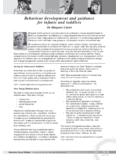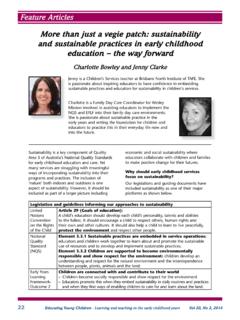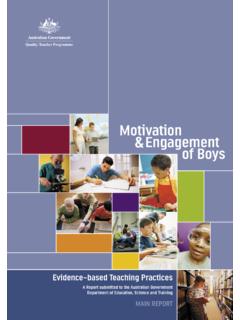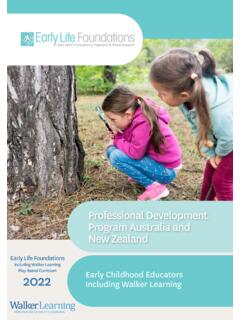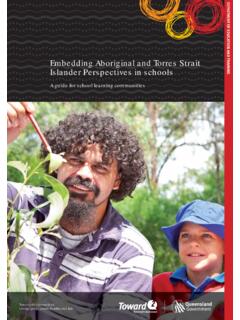Transcription of Embedding Indigenous Perspectives in the Early Childhood ...
1 Feature Articles 37 Educating Young Children - Learning and teaching in the Early Childhood years Vol 17, No 2, 2011 Embedding Indigenous Perspectives in the Early Childhood CurriculumMelinda MillerMelinda Miller is a lecturer in the School of Early Childhood at QUT. Her research, teaching and publication interests include culture studies, Indigenous studies, sustainability education and professional development for Early Childhood educatorsEarly Childhood curriculum frameworks place strong emphasis on the need for educators to build cultural competence.
2 In the Australian context, a key component of this work relates to competencies with acknowledging and responding to Aboriginal and Torres Strait Islander cultures and communities. Despite emphasis on the importance of this work, the how and why of Embedding Indigenous Perspectives continues to raise concerns for many non- Indigenous educators. Educators may question their approach, knowledge base, and the right to teach about cultural ways of being, knowing and that are different to their own Perspectives (see Lampert, 2005). It is recognised that non- Indigenous educators cannot be experts on Indigenous Australia (Lampert, 2005), although they can demonstrate preparedness to understand and value cultural diversity.
3 When doing so, educators access and make use of appropriate resources, design inclusive curricula, and engage the support and expertise of others including families and members of the local Indigenous community. Educator preparedness also relates to deep knowledge of how a person s own cultural background influences their thinking and practices, and shapes how they view and respond to people from cultural backgrounds different from their own. Evaluating approaches to Embedding Indigenous perspectivesAs the majority of educators in Australia are non- Indigenous , ongoing discussion and critique of attempts to embed Indigenous Perspectives is imperative.
4 In my work in non- Indigenous child care services, I have noted the different ways educators make attempts to embed Indigenous Perspectives in practice. Differences in this work can be seen in the ways educators: assemble and use resources including books, posters and dollsgive recognition to Indigenous sovereignty andform genuine working relationships with Indigenous line with broader approaches to Reconciliation (see Burridge, 2009), educators work is often reflective of practical, symbolic or substantive approaches to Embedding Indigenous Perspectives .
5 The table on the following page outlines some examples of practice that align with these three approaches. It provides a useful framework for educators to use when considering the prevalence of particular practices within their service, as well as ways to develop their work further. When used in combination, these three approaches to Embedding Indigenous Perspectives can result in effective practices. A practical approach provides visual cues to families and visitors that Indigenous Perspectives are a key part of the daily curriculum. Practices aligned with a symbolic approach give recognition to Indigenous sovereignty and can provoke educators to rethink what they Feature Articles38 Educating Young Children - Learning and teaching in the Early Childhood years Vol 17, No 2, 2011understand about historical and contemporary circumstances for Indigenous and non- Indigenous people in Australia.
6 A substantive approach makes space for Indigenous self-representation, meaning Indigenous people can represent themselves in ways in which they want people to know about and relate to them (Chalmers, 2005). While there are benefits to all three approaches, there are also cautions about how the work of Embedding Indigenous Perspectives is framed and understood, as outlined When used in isolation, a practical approach can be tokenistic. Resources and experiences that are reflective of Indigenous peoples and cultures should be core to the curriculum, rather than being add-ons or one-off activities.
7 Experiences focussed on music, art and dance provide important avenues for exploration, but shouldn t be used in place of rich discussion about diversities within and across Indigenous groups, and broader resources may show stereotypical or negative images of Indigenous peoples and cultures. Consider if there is a balance of more traditional and contemporary images available in the classroom. Monitor teacher-talk and the ways children talk about and make use of the resources available to if there is ongoing discussion about the purpose of displaying symbols of Indigenous sovereignty, including an Aboriginal flag and Torres Strait Islander flag, and map of Aboriginal Australia.
8 What do educators, families and children understand about these symbols? Beyond imagery, how does the service demonstrate acknowledgement and support of Indigenous sovereignty? Are symbols used in place of the presence of Indigenous people? SubstantiveHow are potential interactions between non- Indigenous and Indigenous people framed? Who will benefit most from these interactions? How can interactions promote reciprocal benefits?Different approaches to Embedding Indigenous Perspectives in practiceApproachExamples of practicePractical Inclusion of puzzles, posters, books, dolls, artwork and images representing Indigenous peoples and culturesAtypical curriculum activities such as painting boomerangs and didgeridoos.
9 Dot paintings and outdoor cultural gamesSymbolicDisplay of an Aboriginal flag and Torres Strait Islander flag in the reception area Acknowledgement of Traditional Owners spoken as part of the curriculum and at key eventsMap of Aboriginal Australia on display and used within curriculum activitiesSubstantiveThe development of working relationships with Indigenous people and organisations in the local community Procedures that invite the participation of Indigenous people in decision-making processes Remuneration offered for the expertise of Indigenous peopleThe development of a workforce strategy to employ Indigenous child care professionals within the serviceFeature Articles 39 Educating Young Children - Learning and teaching in the Early Childhood years Vol 17, No 2, 2011 What is it that you are asking Indigenous people to do?
10 Do you have preconceived ideas about how they will represent themselves and participate within service activities? Consider how the service will remunerate Indigenous visitors for their time and questionsAlongside attempts to embed Indigenous Perspectives in practice, educators must continue to evaluate the purpose they attach to this work. Questions about why services should focus specifically on Indigenous Perspectives and how this benefits white children are common. Such questions provide insight into educator knowledge and reflect a need to attach meaning and purpose to one s work.
